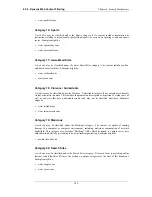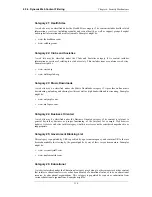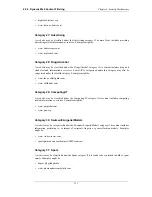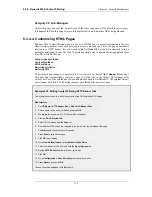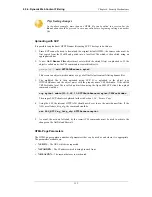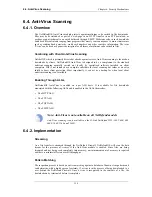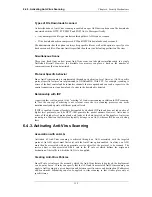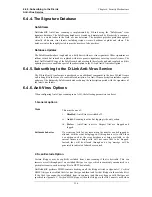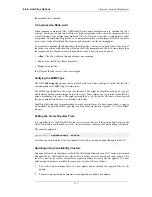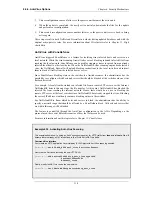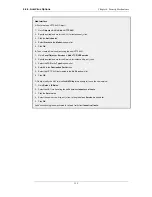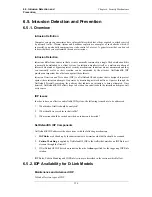
manually propose a new classification of sites.
This mechanism can be enabled on a per-HTTP ALG level, which means that the administrator can
choose to enable this functionality for regular users or for a selected user group only.
If reclassification is enabled and a user requests a web site which is disallowed, the block web page
will include a dropdown list containing all available categories. If the user believes the requested
web site is wrongly classified, he can select a more appropriate category from the dropdown list and
submit that as a proposal.
The URL to the requested web site as well as the proposed category will then be sent to D-Link's
central data warehouse for manual inspection. That inspection may result in the web site being
reclassified, either according to the category proposed or to a category which is felt to be correct.
Example 6.17. Reclassifying a blocked site
This example shows how a user may propose a reclassification of a web site if he believes it is wrongly classified.
This mechanism is enabled on a per-HTTP ALG level basis.
Command-Line Interface
First, create an HTTP Application Layer Gateway (ALG) Object:
gw-world:/> add ALG ALG_HTTP content_filtering
WebContentFilteringMode=Enable
FilteringCategories=SEARCH_SITES
AllowReclassification=Yes
Then, continue setting up the service object and modifying the NAT rule as we have done in the previous
examples.
Web Interface
First, create an HTTP Application Layer Gateway (ALG) Object:
1.
Go to Objects > ALG > Add > HTTP ALG
2.
Specify a suitable name for the ALG, for example content_filtering
3.
Click the Web Content Filtering tab
4.
Select Enabled in the Mode list
5.
In the Blocked Categories list, select Search Sites and click the >> button
6.
Check the Allow Reclassification control
7.
Click OK
Then, continue setting up the service object and modifying the NAT rule as we have done in the previous
examples.
Dynamic content filtering is now activated for all web traffic from lannet to all-nets and the user is able to propose
reclassification of blocked sites. Validate the functionality by following these steps:
1.
On a workstation on the lannet network, launch a standard web browser.
2.
Try to browse to a search site, for example www.google.com.
3.
If everything is configured correctly, the web browser will present a block page where a dropdown list
containing all available categories is included.
4.
The user is now able to select a more proper category and propose a reclassification.
6.3.4.3. Content Filtering Categories
This section lists all the categories used with Dynamic Content Filtering and describes the purpose
6.3.4. Dynamic Web Content Filtering
Chapter 6. Security Mechanisms
305
Summary of Contents for DFL-1600 - Security Appliance
Page 27: ...1 3 NetDefendOS State Engine Packet Flow Chapter 1 NetDefendOS Overview 27 ...
Page 79: ...2 7 3 Restore to Factory Defaults Chapter 2 Management and Maintenance 79 ...
Page 146: ...3 9 DNS Chapter 3 Fundamentals 146 ...
Page 227: ...4 7 5 Advanced Settings for Transparent Mode Chapter 4 Routing 227 ...
Page 241: ...5 4 IP Pools Chapter 5 DHCP Services 241 ...
Page 339: ...6 7 Blacklisting Hosts and Networks Chapter 6 Security Mechanisms 339 ...
Page 360: ...7 4 7 SAT and FwdFast Rules Chapter 7 Address Translation 360 ...
Page 382: ...8 3 Customizing HTML Pages Chapter 8 User Authentication 382 ...
Page 386: ... The TLS ALG 9 1 5 The TLS Alternative for VPN Chapter 9 VPN 386 ...
Page 439: ...Figure 9 3 PPTP Client Usage 9 5 4 PPTP L2TP Clients Chapter 9 VPN 439 ...
Page 450: ...9 7 6 Specific Symptoms Chapter 9 VPN 450 ...
Page 488: ...10 4 6 Setting Up SLB_SAT Rules Chapter 10 Traffic Management 488 ...
Page 503: ...11 6 HA Advanced Settings Chapter 11 High Availability 503 ...
Page 510: ...12 3 5 Limitations Chapter 12 ZoneDefense 510 ...
Page 533: ...13 9 Miscellaneous Settings Chapter 13 Advanced Settings 533 ...



















